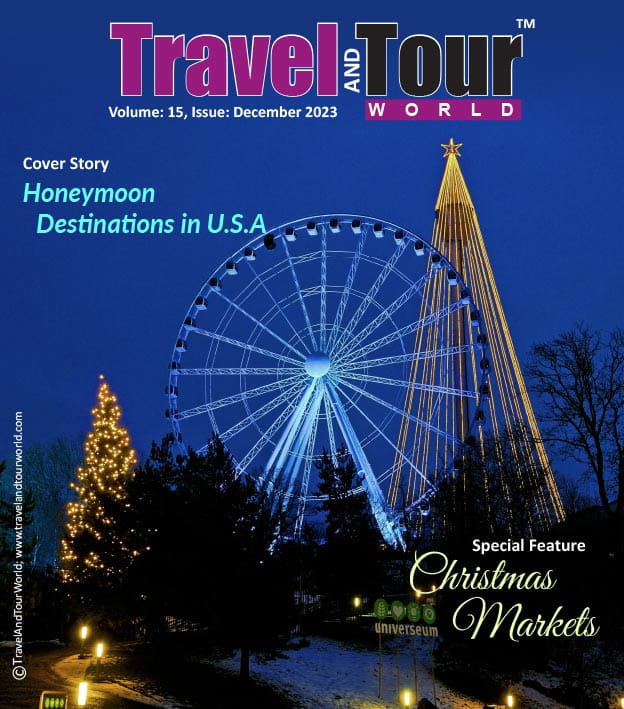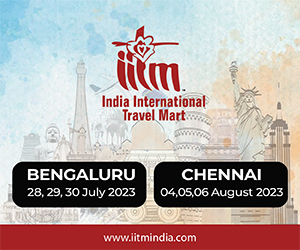
Ms Zsófia Jakab, Deputy CEO of the Hungarian Tourism Agency sheds light on the changed tourism scene of Hungary and shares her achievements and goals in the industry with the readers of Travel And Tour World.
Travel And Tour World: The travel and tourism industry has spent the last two years recovering from the effects of the global pandemic. How has Hungary’s tourism scene changed post-pandemic (for both domestic and international tourism)?
Zsófia Jakab: The Hungarian tourism industry was strongly affected by the global pandemic, and this is reflected clearly in the data. Based on information from the NTDSC, just 8 million guests spent 22.7 million tourism nights in Hungary in 2020, which represents a significant decline from the previous year, in which 42 million guest nights were registered. Within these figures were decreases across a number of categories, including the number of international guests, which stood at just 22% of the 2019 value, and the number of international tourism nights, which reached 27%, although it is worth mentioning that the figure for domestic guests was significantly better, totaling 73% of the numbers recorded in 2019.
However, following the restart of tourism in spring 2021, the industry recorded a major achievement that strongly contributed to its recovery, with Hungary enjoying its best domestic touristic season ever during the summer months, despite the country having been almost completely closed in the first half of the year. Over summer and autumn, the number of domestic guests reached, and in some cases even exceeded, the figures of 2019, primarily in rural Hungary.
Overall, global international tourist arrivals grew by just 4% in 2021, according to statistics from the World Tourism Organization (UNWTO), but in Hungary that indicator showed an increase of 46%, demonstrating that the pace of recovery in the Hungarian tourism industry was far quicker than the global average. Throughout the whole year, almost 29 million tourism nights were recorded at accommodation establishments, exceeding figures from 2020 by 26%, although still trailing 2019 data by 31%.
Many surveys show that in 2022, tourists are travelling in large numbers to make up for their missed trips. We expect to welcome a growing number of international tourists, in addition to domestic visitors.
Travel And Tour World: Hungary is known as a popular destination for dental tourism. Please share some details about the present status of this industry and how it contributes to Hungarian tourism overall.
Zsófia Jakab: Hungary is outstanding in several aspects when it comes to medicine and medical science. The country is at the forefront of diagnostics, dentistry, ophthalmology, orthopaedics, and plastic surgery, and the leading Hungarian institutes provide patients with high-quality service in cutting-edge facilities.
As one of the dentistry hubs of Europe, dental offices outside of Budapest also provide foreign patients with high-quality services in cities along the western border, including Sopron, Mosonmagyaróvár, and Győr.
Another reason for the popularity of Hungary as a dental tourism destination, and the high levels of patient satisfaction, is the combination of treatment with relaxation and spa time. The country is a center for health, medical, and spa tourism, and is extremely rich in thermal waters: around 80% of Hungary’s territory has some kind of thermal water underground, and the country can boast almost 1,500 hot springs, as well as over 270 different mineral and medicinal water bodies.
Additionally, we are delighted to announce that this fall Budapest will play host to the 20th ESE (European Society of Endodontology) Biennial Congress. It will expectantly provide a fantastic opportunity to meet face-to-face with professional friends and colleagues for the first time in more than 2 years.
Travel And Tour World: What are the major tourist attractions in Budapest? What is your expected tourist traffic for the current season?
Zsófia Jakab: Based on our CDR (call detail records) database, in the first half of 2022 the most frequently visited tourist attractions in Budapest were the Parliament area, Margaret Island, and the Liberty Statue (Citadella). In case of all three attractions, the largest number of foreign visitors came from Germany.
Recently, travel habits have changed significantly, and they are still dynamically changing today. Our predictive models indicate that many exogenous factors affect tourist traffic, for example the expectations of residents, economic prospects and effects, foreign and domestic news, and the weather, among others. Overall, by the end of this year, the number of tourism nights could reach 37-39 million, compared with 29 million in 2021, and 42 million in the record year of 2019.
We are also expecting outstanding tourism results in the summer season. Last summer, accommodation establishments in Hungary recorded a total of nearly 15 million overnight stays, and this year this figure could reach around 16.7 million.
Travel And Tour World: Do you have a specific plan to revamp the tourism industry through long-haul flights? Please discuss in detail.
Zsófia Jakab: Hungary’s main entry point is the Budapest Airport, which, prior to the pandemic, attracted 16.1 million passengers annually, of which almost 335,000 were long-haul. However, as a result of the pandemic, airlines significantly reduced their capacity in response to travel restrictions and the drastic drop in demand. When services resumed, the Hungarian Tourism Agency considered the restoration of air connections and the creation of new flights to be of the utmost importance, and thanks to our efforts, traffic through the airport between January and July this year stood at 73% of the traffic compared to the same period in 2019.
In the absence of a national airline to support the recovery effort, the focus has mainly been on cooperation with international airlines to develop and sustain long-haul connections. Our work has led to the reopening of flights to our traditional long-haul markets such as South Korea, the USA, and China, as well as an increase in overall connections since 2022. We are continuously adapting to changes in the markets, and we remain open to new opportunities.
Travel And Tour World: How has COVID-19 impacted Hungary’s incentive industry? What protocols and technological updates have you implemented to ensure safe events?
Zsófia Jakab: In 2022, the incentive industry is experiencing a certain global downturn compared to earlier projections, with companies postponing many of their trips and citing overall uncertainty as the reason for this, whether it be due to Covid, recession, or other global events. However, from 2023 we envisage a steady growth in demand, largely spearheaded by the return of long-haul markets.
With regards to the pandemic, Hungary was one of the most successful countries when it came to tackling the Covid-19 crisis, continually publishing and sharing updated Health & Safety Guidelines formulated with extensive input from tourism professionals.
At the peak of the pandemic, we showcased the new rules at ‘Power of Live Events”, demonstrating the organization of a safe business event. This innovative and courageous initiative has been rewarded with international recognition.
During the pandemic, we also turned to online solutions, and our experiences have led us to view hybrid events as a safe and favorable alternative, even in the long-term. We view online events as a permanent fixture, particularly given that the measurability and long-lasting nature of digital tools can greatly enhance the organization of conferences and business events through the promotion of effective knowledge sharing.
From the perspective of business events, corporate event concepts have been influenced by the association market in the creation of event management solutions offering experiential and scenario-based events that include some form of customer branding.
Another change caused by the pandemic is the introduction of so-called hubs. The ICCA, among other groups, changed its previous practice to this method, connecting participants via hubs to a central venue so as to comply with travel restrictions. Such multisite events also provide opportunities for destinations that are unable to support a full-size World Congress center, but that have capacity to host smaller events.
Travel And Tour World: What kind of guests (upscale or midscale) do you expect to revamp the hotel industry of Hungary? Please discuss in detail with special reference to Budapest.
Zsófia Jakab: Budapest plays a prominent role in Hungary’s tourism, with 30% of the country’s total accommodation turnover linked to the capital. Towards the end of summer 2021 international tourism traffic started to increase, a trend that continued throughout autumn and winter as visitors gradually returned to the Hungarian capital.
In 2021, Budapest welcomed 1.7 million visitors who spent a total of 5.6 million nights there, and this number grew in the first six months of 2022, with an even greater number of foreign visitors to the capital, primarily from the United Kingdom, Germany, France, Israel, and the United States of America. During this time, more than half (51%) of foreign bookings were made in 4-star units and more than a third (36%) in 3-star units, while the proportion of pre-bookings in case of domestic guests was 44% and 34% respectively.
Visitors to Budapest are blessed with a wealth of colourful and historic luxury venues to choose from. These include those dating back to Budapest’s days as a stop on the Grand Tour, as well as modern-day makeovers of fin-de-siècle landmarks, all revamped and renovated to become cosmopolitan destinations of style and standing.
Travel And Tour World: Where do you wish to see Hungary’s travel (MICE tourism included) industry in the next five years?
Zsófia Jakab: Hungary is a colorful, easily accessible, and safe destination. For leisure, classics will remain classics, and Budapest will remain a must-see destination in Europe, but it is our hope that tourists will discover all that Hungary has to offer beyond Budapest, and without even having to go far from the capital. Our offer has been growing steadily in the past few years, and even during the pandemic Hungary has continued to invest in infrastructure, attractions, and heritage preservation, all of which play an important role in the tourist experience. As the supply side gets more diverse, tourists will stay longer in the future and will venture further out to take advantage of new opportunities in different parts of the city, thus decreasing over-crowding and creating slower, more leisurely tourism. More generally, Hungary will retain its unbeatable value for money, which is also certain to have an enormous impact on travelers when they are choosing their destination.
Regarding MICE, Hungary has always been driven by Budapest. With new developments in the city and constantly renewing offers, MICE professionals will always find great opportunities to propose to their clients. Overall, Budapest aims to become a regional hub for MICE tourism, and with the developments of recent years (increased hotel capacity, new venues, conference capacity increase, and the renovation of HUNGEXPO, the biggest multifunctional event center in the region) Hungary will be able to cater for the needs of all events, no matter their size. Additionally, Hungary’s regional offer will diversify demand and grow new regional MICE leaders in neighboring countries.
Monday, January 1, 2024
| Cookie | Duration | Description |
|---|---|---|
| cookielawinfo-checkbox-analytics | 11 months | This cookie is set by GDPR Cookie Consent plugin. The cookie is used to store the user consent for the cookies in the category "Analytics". |
| cookielawinfo-checkbox-functional | 11 months | The cookie is set by GDPR cookie consent to record the user consent for the cookies in the category "Functional". |
| cookielawinfo-checkbox-necessary | 11 months | This cookie is set by GDPR Cookie Consent plugin. The cookies is used to store the user consent for the cookies in the category "Necessary". |
| cookielawinfo-checkbox-others | 11 months | This cookie is set by GDPR Cookie Consent plugin. The cookie is used to store the user consent for the cookies in the category "Other. |
| cookielawinfo-checkbox-performance | 11 months | This cookie is set by GDPR Cookie Consent plugin. The cookie is used to store the user consent for the cookies in the category "Performance". |
| viewed_cookie_policy | 11 months | The cookie is set by the GDPR Cookie Consent plugin and is used to store whether or not user has consented to the use of cookies. It does not store any personal data. |










